Module 7 English for you and me Unit 3 Language in use 课件(共20张PPT) 2024-2025学年英语外研版九年级下册
文档属性
| 名称 | Module 7 English for you and me Unit 3 Language in use 课件(共20张PPT) 2024-2025学年英语外研版九年级下册 | 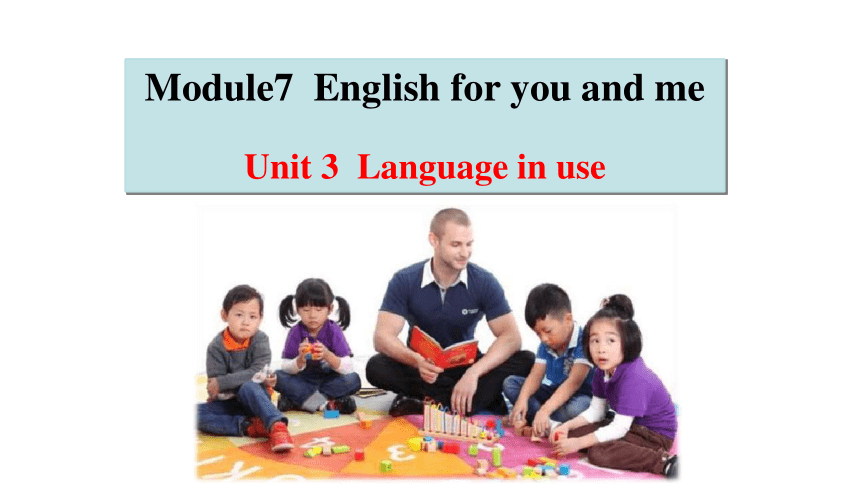 | |
| 格式 | ppt | ||
| 文件大小 | 1.4MB | ||
| 资源类型 | 教案 | ||
| 版本资源 | 外研版 | ||
| 科目 | 英语 | ||
| 更新时间 | 2024-11-21 21:53:00 | ||
图片预览



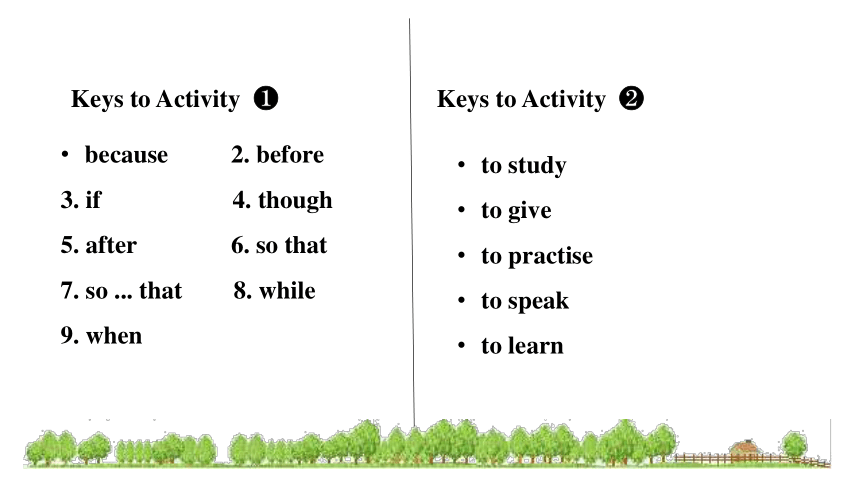
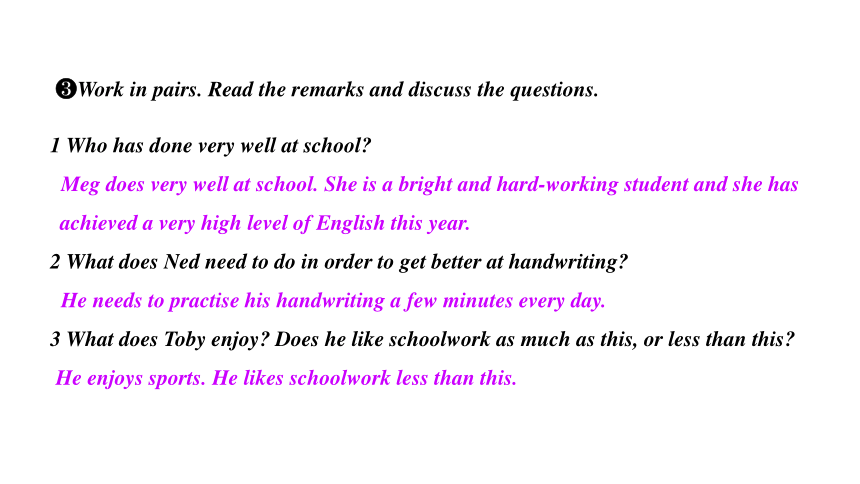
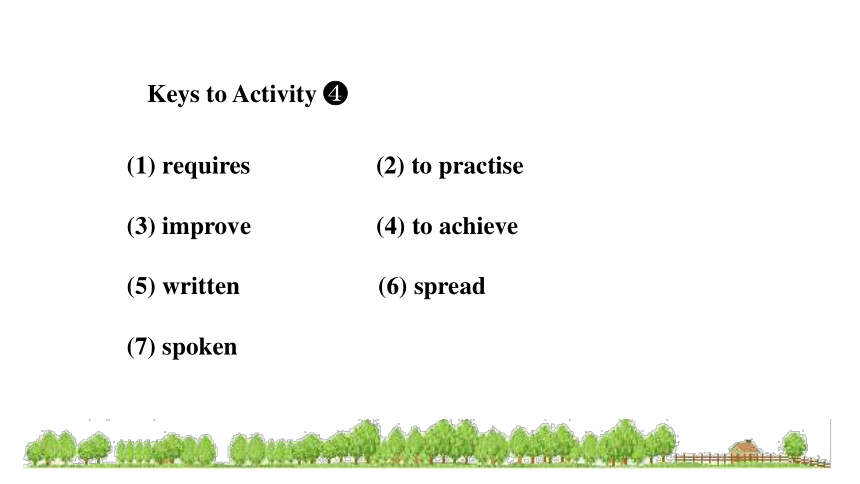
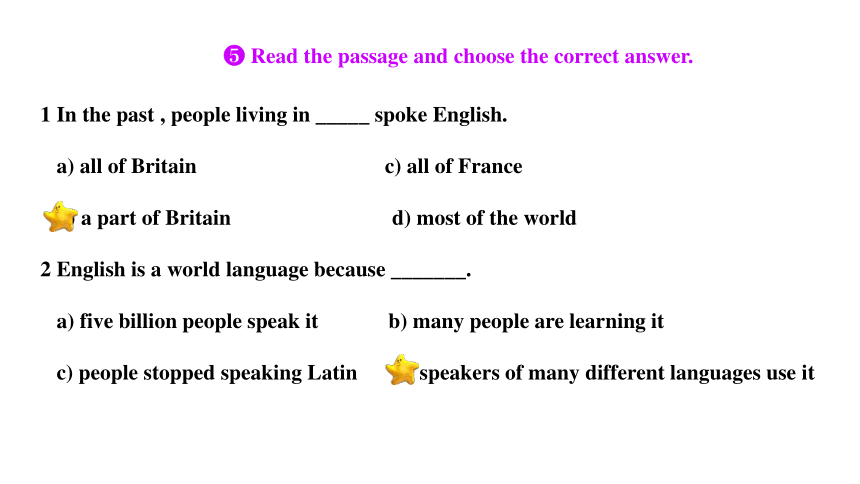
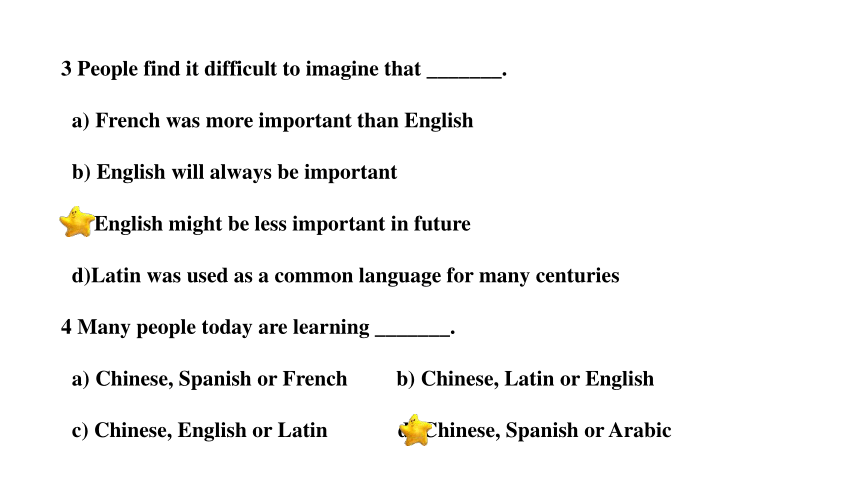
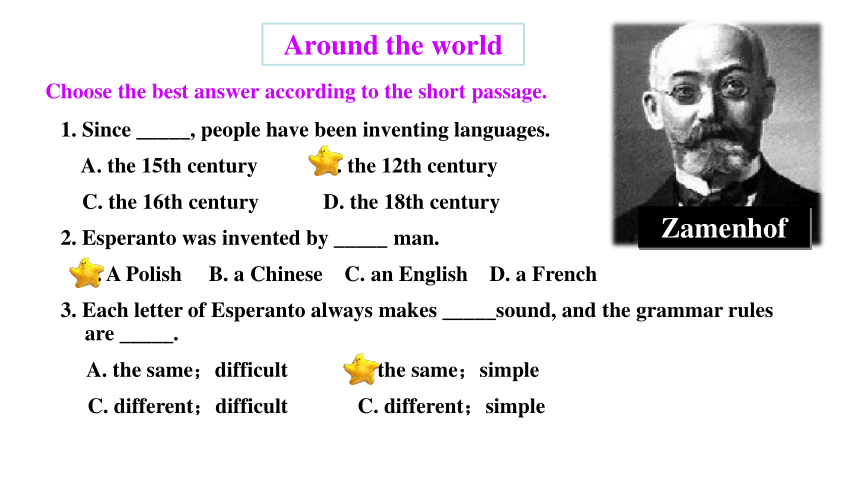
文档简介
(共20张PPT)
Module7 English for you and me
Unit 3 Language in use
掌握状语从句和不定式的用法
Aim 1 知识目标
能够运用所学的句型描述学习某种外国语言时遇到的问题或提出建议, 并能简单介绍学习某种语言的经历。
Aim 2 能力目标
使学生认识到学习英语的重要性, 同时又要看到汉语日益增强的影响力, 培养对汉语的热爱, 增强民族自豪感
Aim 3 情感目标
It’s also the subject that I’m best at, although my spoken English is not that good.
I can speak English with you whenever we meet.
As China continues to grow, many people think that Chinese will become as common as English by the middle of the twenty-first century.
I hope I can continue to make progress next year.
The British, the Indians and the Chinese all help (to) make it a rich language.
Language practice
【教材回顾】
让步状语从句; 原因状语从句; 动词不定式表目的
because 2. before
3. if 4. though
5. after 6. so that
7. so ... that 8. while
9. when
Keys to Activity
Keys to Activity
to study
to give
to practise
to speak
to learn
Work in pairs. Read the remarks and discuss the questions.
1 Who has done very well at school
Meg does very well at school. She is a bright and hard-working student and she has achieved a very high level of English this year.
2 What does Ned need to do in order to get better at handwriting
He needs to practise his handwriting a few minutes every day.
3 What does Toby enjoy Does he like schoolwork as much as this, or less than this
He enjoys sports. He likes schoolwork less than this.
(1) requires (2) to practise
(3) improve (4) to achieve
(5) written (6) spread
(7) spoken
Keys to Activity
1 In the past , people living in _____ spoke English.
a) all of Britain c) all of France
b) a part of Britain d) most of the world
2 English is a world language because _______.
a) five billion people speak it b) many people are learning it
c) people stopped speaking Latin d) speakers of many different languages use it
Read the passage and choose the correct answer.
3 People find it difficult to imagine that _______.
a) French was more important than English
b) English will always be important
c) English might be less important in future
d)Latin was used as a common language for many centuries
4 Many people today are learning _______.
a) Chinese, Spanish or French b) Chinese, Latin or English
c) Chinese, English or Latin d) Chinese, Spanish or Arabic
Choose the best answer according to the short passage.
1. Since _____, people have been inventing languages.
A. the 15th century B. the 12th century
C. the 16th century D. the 18th century
2. Esperanto was invented by _____ man.
A. A Polish B. a Chinese C. an English D. a French
3. Each letter of Esperanto always makes _____sound, and the grammar rules are _____.
A. the same;difficult B. the same;simple
C. different;difficult C. different;simple
Zamenhof
Around the world
一个主句和一个或一个以上的从句构成复合句。根据句法功能从句可以分为名词性从句、形容词性从句和副词性从句。
复合句
名词性从句
形容词性从句
副词性从句(状语从句)
宾语从句
表语从句
主语从句
同位语从句
Grammar ——状语从句
副词性从句(状语从句)
从句种类 连词
时间状语从句 when, while, as, before, after, until
地点状语从句 where
条件状语从句 if
比较状语从句 than, as
目的状语从句 so that, in order that
原因状语从句 because,since, as
结果状语从句 so…that…
让步状语从句 although, though
主句如果是一般将来时或过去将来时,条件和时间状语从句一般用一般现在时或一般过去时。例如:
If it rains tomorrow, we will play inside.
He said if we went to the cinema at the weekend, he would go with us.
Don’t worry. I’ll wait until you come back.
状语从句的时态
动词不定式可在句中作主语、宾语、表语、宾语补足语、定语和状语。
它没有人称和数的变化,其结构为“to + 动词原形”,否定形式为“not to +动词原形”。
初中阶段主要考察动词不定式在句中作宾语、宾语补足语和目的状语。
Grammar ——动词不定式
动词不定式作宾语
类似用法:agree, choose, decide, hope, learn, plan, prepare, want, like, start, begin, fail, wish, try, remember, forget
plan, want, hope, decide等动词,一般只能用动词不定式作宾语,即其后
+to do sth. 表示:“计划、想要、决定、打算做某事”。
He wants to buy some vegetables. 他想要买些蔬菜。
动词不定式作宾语补足语
My mum asks me to play the piano two hours every day.
我妈妈让我每天弹两小时的钢琴。
我们常说的不定式作宾语补足语是指 v. +名词/代词+ (to) do sth. 结构中的不定式。动词不定式可以用来说明宾语的情况。
常带不定式作宾补的动词:
warn, tell, allow, ask, order, get, invite, wish, want, encourage等
notice
listen to
hear
watch
五看
see
look at
observe
三使
let
make
have
二听
一感觉
feel
+ sb. do sth.(不带to)
口诀:
吾看三室两厅一感觉:来帮忙!
动词help后面的动词不定式可带to,也可不带to。
半帮助
help
动词不定式作目的状语
动词不定式用作目的状语,表示某一动作或状态的目的。(做某事是为了什么)
I had to work hard to earn money. 我不得不努力工作赚钱。
He stayed at home to finish his homework. 他留在家里完成作业。
不定式前面加 in order 构成in order to do …可加强语气或使目的意义更加清楚。
She is running quickly in order to catch the train.
为了赶火车,她正飞快地跑着。
知识方面
Revise& master the new words and expressions.
Revise& master some important sentences.
能够运用所学的句型描述学习某种外国语言时遇到的问题或提出建议, 并能简单介绍学习某种语言的经历。
能力方面
掌握状语从句和不定式的用法
1. My father was working at the desk ______ I went in.
A. when B. while C. if D. since
2. —Do you know ______ before —In the People’s Hospital.
A. where is Dave’s father working B. where did Dave’s father work
C. where Dave’s father is working D. where Dave’s father worked
3. —Why are you walking to school? —______ the bus broke down on the way.
A. If B. Since C. Because D. Though
4. I will call you as soon as I _______ the ticket to the football match.
A. am getting B. get C. got D. will get
The patient's illness worries others.
病人之病,忧人之忧。
Module7 English for you and me
Unit 3 Language in use
掌握状语从句和不定式的用法
Aim 1 知识目标
能够运用所学的句型描述学习某种外国语言时遇到的问题或提出建议, 并能简单介绍学习某种语言的经历。
Aim 2 能力目标
使学生认识到学习英语的重要性, 同时又要看到汉语日益增强的影响力, 培养对汉语的热爱, 增强民族自豪感
Aim 3 情感目标
It’s also the subject that I’m best at, although my spoken English is not that good.
I can speak English with you whenever we meet.
As China continues to grow, many people think that Chinese will become as common as English by the middle of the twenty-first century.
I hope I can continue to make progress next year.
The British, the Indians and the Chinese all help (to) make it a rich language.
Language practice
【教材回顾】
让步状语从句; 原因状语从句; 动词不定式表目的
because 2. before
3. if 4. though
5. after 6. so that
7. so ... that 8. while
9. when
Keys to Activity
Keys to Activity
to study
to give
to practise
to speak
to learn
Work in pairs. Read the remarks and discuss the questions.
1 Who has done very well at school
Meg does very well at school. She is a bright and hard-working student and she has achieved a very high level of English this year.
2 What does Ned need to do in order to get better at handwriting
He needs to practise his handwriting a few minutes every day.
3 What does Toby enjoy Does he like schoolwork as much as this, or less than this
He enjoys sports. He likes schoolwork less than this.
(1) requires (2) to practise
(3) improve (4) to achieve
(5) written (6) spread
(7) spoken
Keys to Activity
1 In the past , people living in _____ spoke English.
a) all of Britain c) all of France
b) a part of Britain d) most of the world
2 English is a world language because _______.
a) five billion people speak it b) many people are learning it
c) people stopped speaking Latin d) speakers of many different languages use it
Read the passage and choose the correct answer.
3 People find it difficult to imagine that _______.
a) French was more important than English
b) English will always be important
c) English might be less important in future
d)Latin was used as a common language for many centuries
4 Many people today are learning _______.
a) Chinese, Spanish or French b) Chinese, Latin or English
c) Chinese, English or Latin d) Chinese, Spanish or Arabic
Choose the best answer according to the short passage.
1. Since _____, people have been inventing languages.
A. the 15th century B. the 12th century
C. the 16th century D. the 18th century
2. Esperanto was invented by _____ man.
A. A Polish B. a Chinese C. an English D. a French
3. Each letter of Esperanto always makes _____sound, and the grammar rules are _____.
A. the same;difficult B. the same;simple
C. different;difficult C. different;simple
Zamenhof
Around the world
一个主句和一个或一个以上的从句构成复合句。根据句法功能从句可以分为名词性从句、形容词性从句和副词性从句。
复合句
名词性从句
形容词性从句
副词性从句(状语从句)
宾语从句
表语从句
主语从句
同位语从句
Grammar ——状语从句
副词性从句(状语从句)
从句种类 连词
时间状语从句 when, while, as, before, after, until
地点状语从句 where
条件状语从句 if
比较状语从句 than, as
目的状语从句 so that, in order that
原因状语从句 because,since, as
结果状语从句 so…that…
让步状语从句 although, though
主句如果是一般将来时或过去将来时,条件和时间状语从句一般用一般现在时或一般过去时。例如:
If it rains tomorrow, we will play inside.
He said if we went to the cinema at the weekend, he would go with us.
Don’t worry. I’ll wait until you come back.
状语从句的时态
动词不定式可在句中作主语、宾语、表语、宾语补足语、定语和状语。
它没有人称和数的变化,其结构为“to + 动词原形”,否定形式为“not to +动词原形”。
初中阶段主要考察动词不定式在句中作宾语、宾语补足语和目的状语。
Grammar ——动词不定式
动词不定式作宾语
类似用法:agree, choose, decide, hope, learn, plan, prepare, want, like, start, begin, fail, wish, try, remember, forget
plan, want, hope, decide等动词,一般只能用动词不定式作宾语,即其后
+to do sth. 表示:“计划、想要、决定、打算做某事”。
He wants to buy some vegetables. 他想要买些蔬菜。
动词不定式作宾语补足语
My mum asks me to play the piano two hours every day.
我妈妈让我每天弹两小时的钢琴。
我们常说的不定式作宾语补足语是指 v. +名词/代词+ (to) do sth. 结构中的不定式。动词不定式可以用来说明宾语的情况。
常带不定式作宾补的动词:
warn, tell, allow, ask, order, get, invite, wish, want, encourage等
notice
listen to
hear
watch
五看
see
look at
observe
三使
let
make
have
二听
一感觉
feel
+ sb. do sth.(不带to)
口诀:
吾看三室两厅一感觉:来帮忙!
动词help后面的动词不定式可带to,也可不带to。
半帮助
help
动词不定式作目的状语
动词不定式用作目的状语,表示某一动作或状态的目的。(做某事是为了什么)
I had to work hard to earn money. 我不得不努力工作赚钱。
He stayed at home to finish his homework. 他留在家里完成作业。
不定式前面加 in order 构成in order to do …可加强语气或使目的意义更加清楚。
She is running quickly in order to catch the train.
为了赶火车,她正飞快地跑着。
知识方面
Revise& master the new words and expressions.
Revise& master some important sentences.
能够运用所学的句型描述学习某种外国语言时遇到的问题或提出建议, 并能简单介绍学习某种语言的经历。
能力方面
掌握状语从句和不定式的用法
1. My father was working at the desk ______ I went in.
A. when B. while C. if D. since
2. —Do you know ______ before —In the People’s Hospital.
A. where is Dave’s father working B. where did Dave’s father work
C. where Dave’s father is working D. where Dave’s father worked
3. —Why are you walking to school? —______ the bus broke down on the way.
A. If B. Since C. Because D. Though
4. I will call you as soon as I _______ the ticket to the football match.
A. am getting B. get C. got D. will get
The patient's illness worries others.
病人之病,忧人之忧。
同课章节目录
- Module 1 Travel
- Unit 1 We toured the city by bus and by taxi
- Unit 2 It's a long story.
- Unit 3 Language in use
- Module 2 Education
- Unit 1 They don't sit in rows.
- Unit 2 What do I like best about school?
- Unit 3 Language in use
- Module 3 Life now and then
- Unit 1 They sometimes work harder.
- Unit 2 I think life is better today.
- Unit 3 Language in use.
- Module 4 Rules and suggestions
- Unit 1 You must be careful of falling stones.
- Unit 2 we must keep the camp clean.
- Unit 3 Language in use.
- Revison A
- Module 5 Look after yourself
- Unit 1 We'd better get you to hospital.
- Unit 2 Get off the sofa!
- Unit 3 Language in use.
- Module 6 Eating togethe
- Unit 1 When is the school-leavers' party?
- Unit 2 Knives and forks are used for most Western
- Unit 3 Language in use
- Module 7 English for you and me
- Unit 1 Have you ever been to an English corner?
- Unit 2 We all own English.
- Unit 3 Language in use
- Module 8 My future life
- Unit 1 Here's to our friendship and the future
- Unit 2 I know that you will be better at maths.
- Unit 3 Language in use
- Revison B
